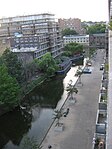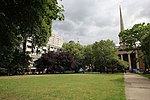Chronicle Tower
Buildings and structures in the London Borough of IslingtonResidential buildings completed in 2016Skidmore, Owings & Merrill buildingsSkyscrapers in the London Borough of Islington

The Chronicle Tower (aka Lexicon Tower) is a 36-storey 115m tall residential building in City Road, London, on the west side of the City Road Basin, part of the Regent's Canal. The closest underground station is Angel. The building includes 146 apartments and is close to the "Square Mile" (London financial city) and "Silicon Roundabout". The architects were Skidmore Owings & Merrill (SOM) who also designed other notable buildings in the world including Willis Tower in Chicago and Burj Khalifa in Dubai. The building has an on-site gym, spa and swimming pool.
Excerpt from the Wikipedia article Chronicle Tower (License: CC BY-SA 3.0, Authors, Images).Chronicle Tower
City Road, London Finsbury (London Borough of Islington)
Geographical coordinates (GPS) Address External links Nearby Places Show on map
Geographical coordinates (GPS)
| Latitude | Longitude |
|---|---|
| N 51.53 ° | E -0.097 ° |
Address
Chronicle Tower
City Road 261B
EC1V 1AJ London, Finsbury (London Borough of Islington)
England, United Kingdom
Open on Google Maps










